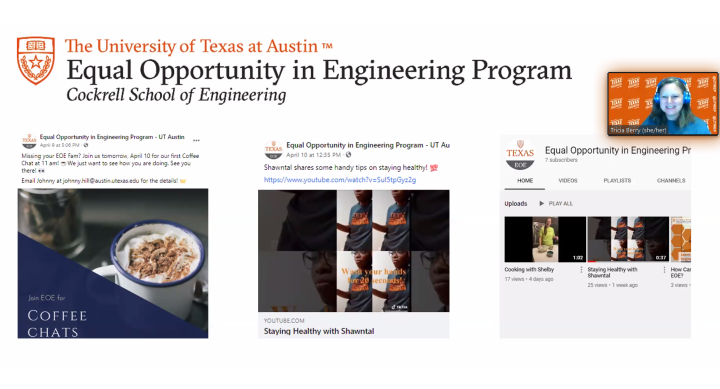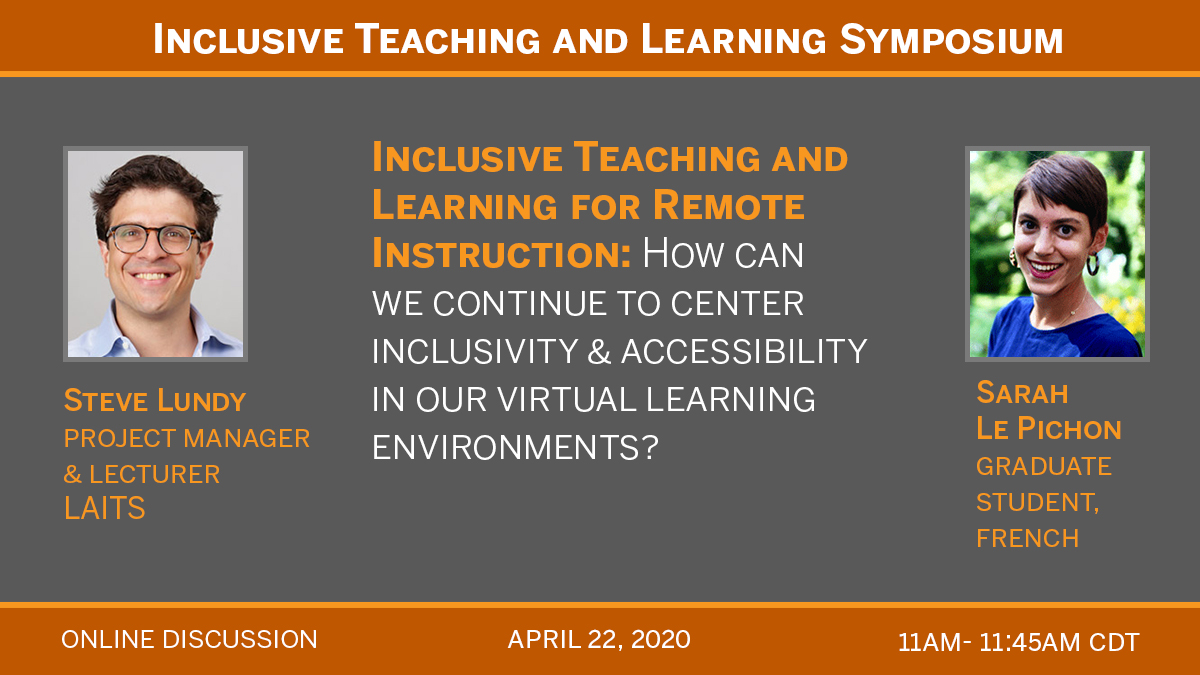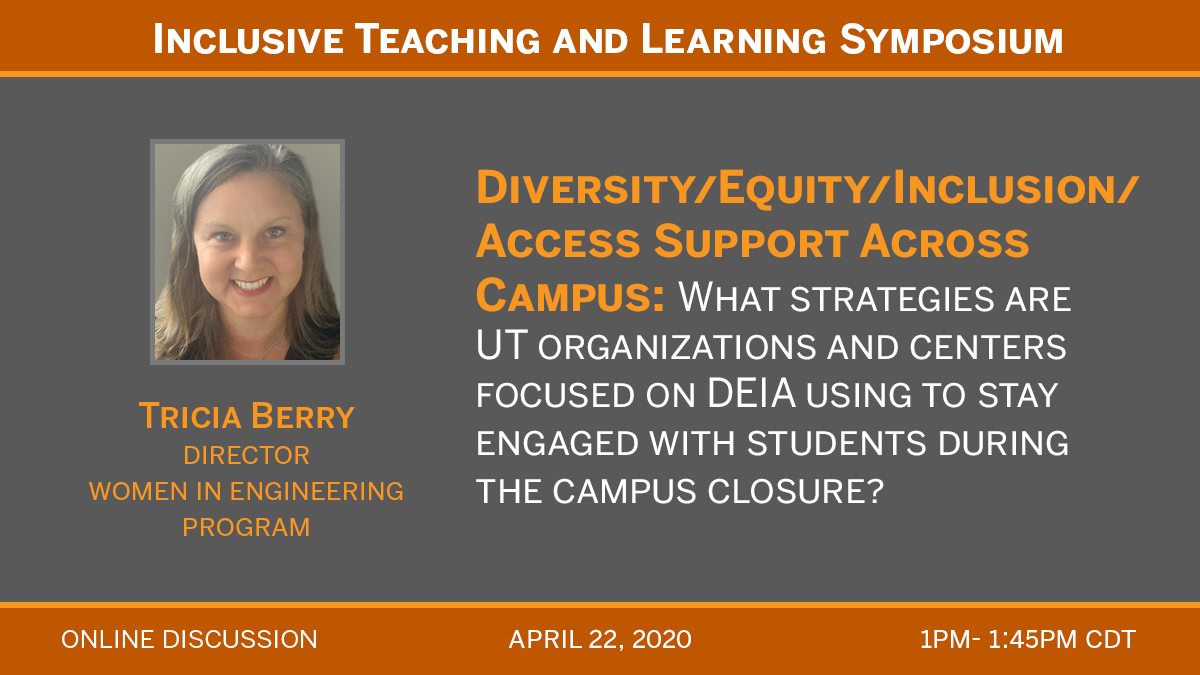
On April 22, 2020, the UT Austin Inclusive Teaching and Learning Symposium adjusted to our campus closure by convening online. This vibrant community showed tremendous flexibility and commitment with over 130 participants in three interactive presentations. We encourage you to review the session summaries written by CTL team members!
Feel free to read by scrolling down the page or you may use the links below.
-
Sarah Le Pichon & Steve Lundy: Inclusive Teaching and Learning for Remote Instruction
-
Shavonne Coleman: Stay Connected
-
Tricia Berry: Diversity / Equity / Inclusion / Access Support Across Campus

Our excellent colleagues Sarah Le Pichon (Graduate Student, French Studies) and Steve Lundy (Lecturer, Classics) facilitated the first session of the symposium. Sarah and Steve highlighted trauma-informed pedagogy as an important framework to help us navigate the campus Covid-19 response, as we’re all involved in a crisis of dramatic proportions that continues to unfold with an uncertain path. They stressed the importance of acknowledging the prevalence of trauma as crucial to articulating coping and pedagogical strategies. At a time when it’s easier than ever for students to drop of our radar, engaging with students using trauma-sensitive practices and policies will help them succeed as learners. Sarah and Steve stressed that it’s hard for us to even imagine all of the factors that are influencing our students’ performance in our classes, such as depression, anxiety, food scarcity, housing challenges, and intimate partner violence. Actively working against retraumatization, secondary traumatization, and new traumatizations in the delivery of our courses and services help us become a part of students’ resiliency strategy.
To help us imagine how to integrate these practices in our own learning environments, the presenters shared several practical trauma-informed pedagogical strategies, such as: (re)prioritizing assignments and expectations in light of current circumstances, updating syllabi to incorporate self-care practices and resources, and providing opportunities for check-ins via online office hours. In addition, we engaged in a conversation about how and whether David Treleaven’s Principles for Trauma-Informed Communication, respect, allyship, and empathy, could be applied to our context as educators. We discussed compelling questions such as: can we view our students as allies, as humans who are going through this difficult time with us? As such, can we find trends across the challenges we are all facing and work through them together? Can we practice empathy, have conversations about what’s depleting us and support each other in engaging in restorative practices?
Finally, we discussed the careful balance required for showing compassion for our students while being mindful of professional boundaries. Being knowledgeable about campus resources that help students heal can give us confidence in striking that balance. Steve and Sarah emphasized the value of these resources: Counseling and Mental Health Center, Voices Against Violence, Behavioral Concerns Advice Line, Student Emergency Services, and Crisis Text Message Service with culturally competent counselors for students of color. Empowering ourselves with an understanding of support services for students can help liberate us to teach with compassion.
Written by Molly Hatcher

Quick! Strike a pose that represents how you are feeling right now. Are you chugging your coffee? Pulling your hair? Looking dazed at your computer camera? In the session, “Staying Connected: What does socially distanced community-building look like?” Shavonne Coleman asked participants to use movement to represent their feelings and those were just some of the responses people quickly shared on their screens.
Shavonne Coleman, Interactive Theatre Specialist with Voices Against Violence (VAV) and Lecturer, Department of Theatre and Dance, has extensive experience in theatre and using theater practices to discuss inter-personal violence prevention. In order to enter into these conversations, she builds an environment in which people can create and maintain community and spark conversation. In this session, Shavonne shared some of those strategies she employs with students to foster rapport and how to adapt them to online spaces. Shavonne used trauma-informed pedagogy/care to frame the conversation around building community and promoting diversity, equity, inclusion, and access in our lessons and spaces. How can you create an maintain a brace/safe space for students to push boundaries and explore? Many of these practices used in face-to-face classes can be extended to online spaces. Instructors can create predictable routines for students; continue sharing agenda for class days, lessons, and units; revisit class agreements that promote positive learning environments; share pronouns; and lead class or an online module with a moment for centering and reflection.
At the core of the trauma-informed model is practicing empathy. Everyone has been affected by COVID and for many of our students, we may not fully grasp their circumstances and lived experience during this pandemic. That’s why encouraging your students and providing flexibility is essential for their success. For instance, in what ways can you provide opportunities for students to engage with each other and course content in asynchronous platforms like Canvas Discussions or Padlet? Are there ways they can express their knowledge differently than formal exams? Finally, Shavonne recommends ending a session (asynchronous or synchronous) with an “appreciation, an apology, or an ah-ha moment” to re-center the class and bring back another chance to engage with each other and build community. Losing the dedicated classroom time together is tough, but it doesn’t mean we have to miss out on the community and comradery built in those spaces, either.
Written by Laura Struve

Our third and final session of the day focused on inclusive teaching and learning strategies for use outside of the classroom, and was facilitated by Tricia Berry, the Director of the Women in Engineering Program. Tricia’s session outlined three main goals for continued support during remote instruction: communication, support, and connection. She explained how her program has, with varying levels of success, striven to continue these three goals in their center, and participants shared their own methods and the challenges they’ve been facing. Below are some of the takeaways from their conversation.
First and foremost, communication is more important now than ever as resources change, events are altered or postponed, and expectations on students (as well as faculty and staff) are continuously altered as time progresses. While things like posters and flyers have clearly become obsolete, distribution of regularly recurring newsletters and utilization of Canvas updates and messaging are lifelines that campus centers and organizations can begin or continue to use to reach students with updates and news. Additionally, new resource creation is practically mandatory for some UT centers and organizations, and is also something that folks are having to tackle while in self-isolation. This means that resources are changing and evolving as staff members find new ways to make them efficiently and effectively. Creating and/or repurposing resources that specifically support students’ needs during the COVID-19 outbreak are generally the most popular—many virtual resources and asynchronous options are as popular, or more popular, than before remote learning began.
Connection is more important than ever before for students, not to mention faculty and staff. However, what students need out of those connections has drastically shifted in many cases. Some folks have found that synchronous remote events have low-to-no attendance, as students do not feel driven to attend extra-curricular events on Zoom. Others have noted that smaller, one-on-one connections are increasingly important and popular—office hours and coffee chats are still popular with students. Yet others have noted that the biggest change is in why students need connection. For many students, having campus resources remain visible and accessible can serve as a constant through a very stressful, unsure time. Our campus resources are sometimes a lifeline for students as they navigate incredible changes, disappointments, and challenges, so continuing to provide options is crucial.
Finally, and possibly most importantly, this moment is an excellent opportunity to listen to and learn from communities that have already been dealing with all of these issues for some time. Emily Shryock, Assistant Director of Services for Students with Disabilities, noted that many of our students have been managing elements of remote learning for years, and some students with disabilities have noted that many of the changes we’re making should be permanent—creating multiple methods through which students can approach resources is vital for accessibility and inclusion, both in the classroom and in our other campus organizations and centers. This moment in time can and should be an opportunity for all of us to reflect on our spaces and our work and think about how, once remote learning is over and we re-enter the physical spaces of UT, we will continue to offer students a variety of approaches and methods in all that we do.
Written by Sarah Schoonhoven

